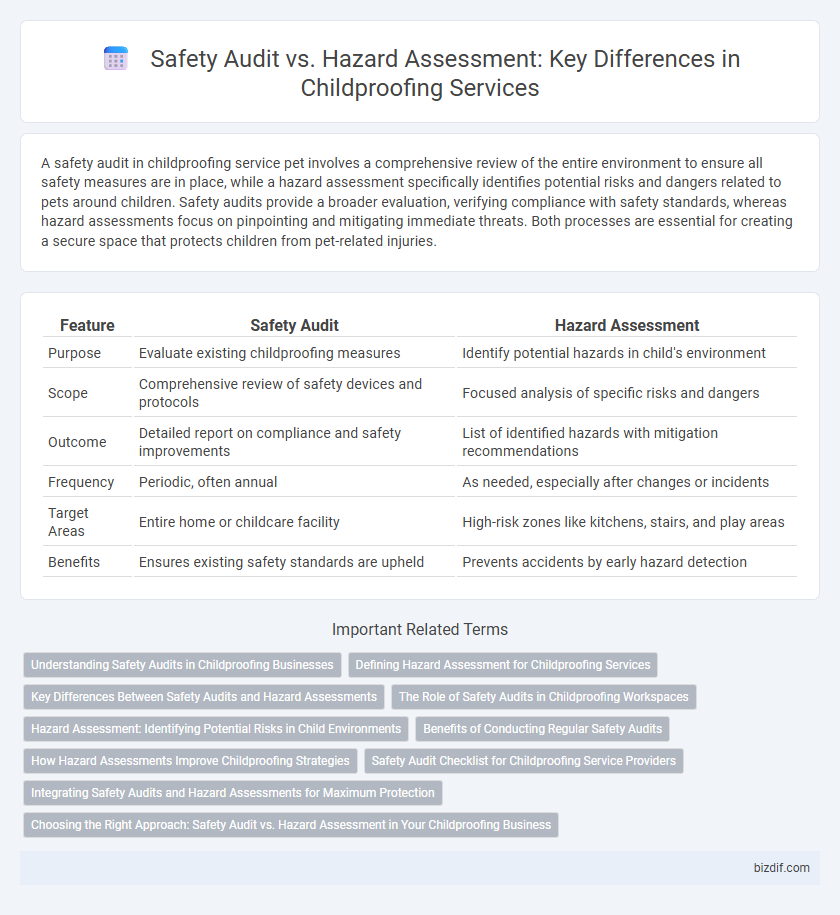A safety audit in childproofing service pet involves a comprehensive review of the entire environment to ensure all safety measures are in place, while a hazard assessment specifically identifies potential risks and dangers related to pets around children. Safety audits provide a broader evaluation, verifying compliance with safety standards, whereas hazard assessments focus on pinpointing and mitigating immediate threats. Both processes are essential for creating a secure space that protects children from pet-related injuries.
Table of Comparison
| Feature | Safety Audit | Hazard Assessment |
|---|---|---|
| Purpose | Evaluate existing childproofing measures | Identify potential hazards in child's environment |
| Scope | Comprehensive review of safety devices and protocols | Focused analysis of specific risks and dangers |
| Outcome | Detailed report on compliance and safety improvements | List of identified hazards with mitigation recommendations |
| Frequency | Periodic, often annual | As needed, especially after changes or incidents |
| Target Areas | Entire home or childcare facility | High-risk zones like kitchens, stairs, and play areas |
| Benefits | Ensures existing safety standards are upheld | Prevents accidents by early hazard detection |
Understanding Safety Audits in Childproofing Businesses
Safety audits in childproofing businesses systematically evaluate the effectiveness of installed safety measures to prevent accidents and injuries in homes. These audits involve thorough inspections of safety gates, outlet covers, and furniture anchors to ensure compliance with industry standards and regulations. Conducting regular safety audits helps identify potential vulnerabilities and maintain a secure environment for children, enhancing overall child safety management.
Defining Hazard Assessment for Childproofing Services
Hazard assessment for childproofing services involves identifying and evaluating potential risks and dangers within a child's environment to prevent accidents and injuries. It focuses on analyzing specific areas such as electrical outlets, sharp furniture edges, choking hazards, and accessibility to harmful substances. This detailed process ensures that tailored safety measures and protective devices effectively mitigate identified hazards, enhancing overall child safety.
Key Differences Between Safety Audits and Hazard Assessments
Safety audits systematically evaluate the overall effectiveness of childproofing measures by reviewing policies, procedures, and compliance with safety standards. Hazard assessments focus specifically on identifying and analyzing potential risks and dangers within a child's environment, such as sharp edges, toxic substances, or unsecured furniture. The key difference lies in scope: audits provide a comprehensive review for continuous improvement, while hazard assessments target immediate risk identification and mitigation.
The Role of Safety Audits in Childproofing Workspaces
Safety audits play a critical role in childproofing workspaces by systematically identifying potential hazards that could pose risks to children. These audits involve a comprehensive evaluation of the environment, including furniture stability, electrical outlets, and access to harmful substances, ensuring compliance with child safety standards. Implementing regular safety audits helps prevent accidents and creates a secure, child-friendly environment in homes, schools, and daycare centers.
Hazard Assessment: Identifying Potential Risks in Child Environments
Hazard assessment in childproofing involves systematically identifying potential risks such as sharp edges, choking hazards, or toxic substances within a child's environment. This process prioritizes direct observation and evaluation of everyday spaces like playrooms, kitchens, and bathrooms to pinpoint specific dangers. Comprehensive hazard assessments enable tailored safety solutions that reduce the risk of injury and create a secure living area for children.
Benefits of Conducting Regular Safety Audits
Regular safety audits in childproofing services identify potential risks and ensure compliance with safety standards, significantly reducing the likelihood of accidents. These audits provide a systematic evaluation of the environment, allowing for timely updates and improvements to protective measures. Consistent safety audits foster peace of mind for parents and caregivers by maintaining a secure space for children's activities.
How Hazard Assessments Improve Childproofing Strategies
Hazard assessments identify specific risks within a child's environment by examining potential dangers such as sharp edges, toxic substances, and unsecured furniture, enabling tailored childproofing solutions. Unlike general safety audits, hazard assessments provide detailed insights that directly influence effective prevention measures, reducing accident risks significantly. Integrating hazard assessments into childproofing strategies ensures a comprehensive approach, enhancing overall safety and peace of mind for parents and caregivers.
Safety Audit Checklist for Childproofing Service Providers
A Safety Audit Checklist for childproofing service providers systematically evaluates all potential risks in a home environment, ensuring compliance with child safety standards and regulations. Unlike a hazard assessment that identifies specific dangers, the safety audit checklist provides a comprehensive framework for inspecting furniture stability, electrical outlet covers, toxin-free materials, and secure stair gates. Implementing this checklist helps providers deliver thorough childproofing solutions that prevent accidents and promote a safe living space for children.
Integrating Safety Audits and Hazard Assessments for Maximum Protection
Integrating safety audits and hazard assessments creates a comprehensive childproofing strategy that identifies potential risks and evaluates the effectiveness of existing safety measures. Safety audits systematically review child environments to ensure compliance with safety standards, while hazard assessments focus on recognizing and prioritizing specific dangers like choking hazards or toxic substances. Combining these approaches maximizes protection by addressing both current vulnerabilities and preventing future incidents in homes, schools, and childcare facilities.
Choosing the Right Approach: Safety Audit vs. Hazard Assessment in Your Childproofing Business
A safety audit systematically evaluates existing childproofing measures to ensure compliance with safety standards, while a hazard assessment identifies potential risks and vulnerabilities in the environment before implementing childproofing solutions. Choosing between a safety audit and hazard assessment depends on whether the goal is to verify current safety controls or proactively detect hazards to prevent accidents. Integrating both approaches enhances comprehensive risk management and strengthens the overall effectiveness of a childproofing business.
Safety audit vs Hazard assessment Infographic

 bizdif.com
bizdif.com